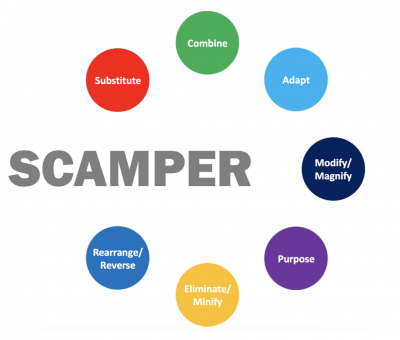
SCAMPER uses a series of questions designed to probe alternative ways of improving processes and products. It is a form of structured brainstorming. In this article, we will explore the specific questions you would use, the benefits and best practices for SCAMPER, and describe an example of how it can be used.
Overview: What is SCAMPER?
SCAMPER is a form of brainstorming used to generate creative ideas for improving your processes and products.
SCAMPER originated in 1953 with Alex Faickney Osborn, who is credited with the development of many of the questions used in SCAMPER. Bob Eberle, in 1971, organized the questions and came up with the acronym SCAMPER in his book entitled SCAMPER: Games for Imagination Development.
Below is a graphic of the components of SCAMPER.

Let’s look at each element and explore a few of the questions you might ask.
Substitute
- Can you substitute or swap materials or resources to improve the product?
- Are there other products or processes you can use?
- What rules could you substitute?
Combine
- Can you combine this product with another to create something new?
- What could you combine to maximize the use of this product?
- Can you use a new combination of people and resources to create a new approach?
Adapt
- How can you adapt the product to serve another purpose or use?
- How can the product be used in a different context?
- What other products or ideas could you use?
Modify
- How could you change the shape, look, or feel of your product?
- How can you modify the product to create more value?
- What element of this product could you strengthen to create something new?
Put to Another Use
- Can you use this product somewhere else?
- Who else could use this product?
- Can waste from this product be used to make something new?
Eliminate
- How could you streamline or simplify this product?
- What features, parts, or rules could you eliminate?
- How could you make it smaller, faster, lighter, or more fun?
Reverse
- What would happen if you reversed the process or rearranged things differently?
- What would happen if you did the opposite of what you do now?
- What roles could you reverse or rearrange?
3 benefits of SCAMPER
A simple, structured approach to brainstorming will result in more and better ideas. SCAMPER is a good tool for accomplishing this.
1. Provide a platform for creative thinking
By using the questions of SCAMPER, you will force people out of their comfort zone to explore creative solutions.
2. Create an environment for generating ideas
The goal of any brainstorming activity is to generate many creative ideas. They may not all be good, but that is not the purpose of brainstorming. Other tools, such as the Affinity Diagram and Fishbone Diagram can be used to evaluate and select the best solutions.
3. Structured approach
Many times, brainstorming is thought of as a wild, free-flowing, unmanaged session of tossing out random ideas. While creativity is the main purpose of brainstorming, the SCAMPER structure will help in maintaining a proper environment for optimal idea generation.
Why is SCAMPER important to understand?
SCAMPER is an important tool for brainstorming ideas, so it is important to know how to use it.
It is structured
SCAMPER provides a list of specific questions to use as guidelines for generating ideas. It is not free-flowing or chaotic.
Flexible
SCAMPER can be used to improve products and processes.
Questions are not all inclusive
Different resources have different questions for each of the SCAMPER elements. You can create your own based on your unique circumstances.
An industry example of SCAMPER
Company X is in the business of producing portable containers for consumable liquids such as coffee. Rather than start from scratch with a new design, they decided to use SCAMPER on their best-selling container to try and create something new from the existing design.
Here were some of their questions.
- Substitute: Could you substitute a plastic cap for the current metal cap to better retain heat? Could you use a more environmentally-friendly manufacturing process that could appeal to ecologically concerned consumers?
- Combine: Can you combine graphics from other products to make the container more attractive?
- Adapt: Can you adapt the design so the container could extend to hold more liquid?
- Modify: Can you modify the design so it is more comfortable to hold and transport?
- Put to another use: Can the product be used to hold food in addition to liquids?
- Eliminate: Can you eliminate parts of the design that protrude so it will fit better into pockets or backpacks?
- Reverse: While the current design is for hot liquids can you reverse things and make it useful for cold liquids as well?
3 best practices when thinking about SCAMPER
While there are a variety of ways to utilize SCAMPER, here are a few hints that might help make your SCAMPER sessions more effective.
1. Best used for existing processes and products
SCAMPER is used primarily for improving existing products and processes. There are other tools, like DMADV and DMEDI, for creating products and services when they don’t currently exist.
2. Don’t evaluate ideas too early
SCAMPER should generate as many ideas as you can. Don’t worry about evaluating ideas during your session. You don’t want to inhibit or turn people off by making judgments too early in the process.
3. Go broad not deep
Apply the questions to a broad array of product and process characteristics such as values, benefits, services, touch points, product attributes, pricing, markets and essentially any other related aspect you might be able to think of.
Frequently Asked Questions (FAQ) about SCAMPER
What does SCAMPER stand for?
It stands for Substitute, Combine, Adapt, Modify, Put to another use, Eliminate and Reverse.
What is SCAMPER used for?
It is a structured form of creative brainstorming used to generate ideas for improving products or processes.
Who developed the SCAMPER technique?
Alex Osborn is credited with the development of the questions used in SCAMPER. Bob Eberle later refined the questions and created the acronym SCAMPER, where the elements are Substitute, Combine, Adapt, Modify, Put to another use, Eliminate and Reverse.
SCAMPER in a nutshell
SCAMPER is a simple and powerful technique for creating large quantities of ideas to improve products or processes. A series of questions are used in the seven elements of SCAMPER to evaluate whether something can be substituted, combined, adapted, modified, put to another use, eliminated, or reversed.